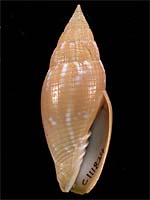|
< Previous family introduction |
|
|||||
 |
Family
Mitridae
Mitres
|
|||||
|
The family Mitridae, along with the two closely related families Costellariidae and Volutomitridae, form a group of large shells commonly known as mitres. They are fusiform in shape with a narrow aperture, with plaits on the columella, and are frequently attractively coloured. They occur in tropical and temperate waters throughout the world, with the greatest concentration in the tropical Indian and Pacific Oceans. They generally occur in the low intertidal and shallow subtidal, living in clean, muddy, or silty sand, or beneath rocks or coral. They are carnivorous animals; as far as is known their food is restricted to sipunculid worms. They deposit eggs in capsules attached to the substrate. The Costellariidae was separated from the Mitridae in 1972 (Ponder, 1972b) on anatomical characters: the nature of the foregut gland, the accessory salivary gland, the kidney, the anal gland and the radula. Fortunately the three families can generally be separated on shell characters. The species of Mitridae have spiral sculpture, although it may be weak or absent, while the Costellariidae species usually have predominately axial folds, sometimes restricted to the early whorls. The taxonomy of the Mitridae is well developed, due to the work of Walter Cernohorsky, formerly of the Auckland Institute and Museum. Cernohorsky published a generic revision of the family in 1970, followed by detailed analysis of the species in two parts, in 1976 and 1991. (References to these works are give under Family References below). The NSW species have suffered numerous changes of name because of the introduction of specific names by Iredale and Laseron for what are now regarded as minor variations in morphology. However, Laseron (1951) provided useful details on the protoconchs of some species. The members of the family which occur in NSW fall into two distinct groups. The widespread tropical Indo-West Pacific fauna is well represented in Queensland, and intrudes into northern NSW, with specimens being taken uncommonly down to Woolgoolga, and occasionally further south. The other part of the fauna is restricted to eastern and southern Australia, with some species having a range not much beyond the borders of NSW. Four species of these are dark brown shells that occur on rocky shores in the low intertidal and shallow subtidal; the other two species occur subtidally down to several hundred metres. Family References
All the NSW species of the families are treated in detail, with the exception of the following which have a tropical distribution and occur rarely in northern NSW:
Identification notes Mitrids have a narrow aperture, with plaits on the columella, and a notch for the siphonal canal. There is no operculum. The outer lip is simple, with no lirae internally. Sculpture is generally lacking or spiral. Members of the Costellariidae differ by generally having axial folds, and may have lirae inside the outer lip. In the Volutomitridae the animals sometimes have an operculum; the shells have an unnotched siphonal canal, and the first fold on the columella is smaller and shorter than the second. The family Columbellidae has shells of a similar shape to Mitridae, but without plaits on the columella.
|